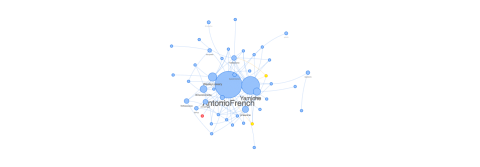Question: How does the network map from the week immediately following the shooting of Michael Brown compare to the network map from the first four days immediately following the grand jury decision that Darren Wilson will not be charged?
For my search, I decided to filter in the key words Race OR Racism OR Police and the tags journalists and activists to compare network maps from immediately after the shooting and immediately after the grand jury decision. I was interested in seeing who the major influencers were during these times, and who was networking with who. I was curious to discover if activists and journalist were networking with one another, or whether these two groups were polarized. For my research project, I am also comparing these two major events, and therefore these network maps will give me insight into who is tweeting about topics related to race, racism, and police after the shooting, and the after the grand jury decision.
Based on the network map immediately following the shooting, Antonio French, an activist and alderman, is the main influencer, and center of the network. Yamiche Alcndor, a New York Times reporter, is the second most influential person on the map. There is group density surrounding Antonio French and Yamiche, which reveals close connections with these two central figures. This network map is not polarized between journalists and activists, as seen through the close connections among activists and journalists, specifically between French and Alcnador, and within the higher density groups. Even among less influential activists and journalists on the outskirts of the map, activists and journalist are connecting with one another through following, replying, or mentioning one another (Raine et al., 2014). However, there are journalists connecting with only journalists on the outskirts. It would be fascinating if this map included how journalist and activists were connecting and communicating with one another in terms of retweets, likes, mentions, or replies. Having this information could provide insight into communication dynamics. I wonder what motivates a journalist or activist to retweet, reply to, or like what another activist or journalist said. In reference to Brugess, Mahart, and Cornelius, retweets could be endorsements, and replies could be a means of communication (2014).
Based on the network map immediately following the grand jury decision, Deray Mckesson, an activist, and Jon Swaine, a reporter are the central most influential people. Deray was a much less influential figure after the shooting, which reveals that the main influencers on twitter changed between the shooting and the grand jury decision. There is much group density surrounding Deray and Swaine, which provides insight into the close networks between journalists and activists. There are also influential tweeters on the outskirts of the map that form their own networks, and are disconnected from the main influencers, a finding that was not as apparent on the map after the shooting. For example, Chris King, a journalist, is the central influencer within a smaller network of journalists and activists. This network is a broadcast network because the activists and journalists connected to King are not connected to and communicating with one another (Raine et al., 2014). Their retweets, replies, mentions, or likes are directed solely at king, not one another. Therefore, King is considered to be the “echo” because each individual is connected to him separately from each other (Fisher, Waggle, Jasny, 2015). Information is coming from one source, and therefore members within these broadcast networks cannot broaden their perspectives (Fisher, et al., 2015).
There are also smaller networks with only activists or only journalists. These smaller networks are known as community clusters where people are connecting and interacting with one another in smaller groups (Raine et al., 2014). These clusters have their own influencers, audience, and information outlets, and are engaging in their own conversation separate from the central group. These smaller networks do create group isolation, while the activists and journalists within these groups are only receiving information from one another Fisher et al., 2015). Additionally, although few, there are also isolated two-way networks solely between activists and journalists that do not connect with anyone else but one another. It would be interesting if the map illustrated how community clusters interacted with one another, and how their conversation differed from the main cluster. This finding would reveal insight into the separate conversations that are happening among smaller groups and among the central group.
- Log in to post comments

